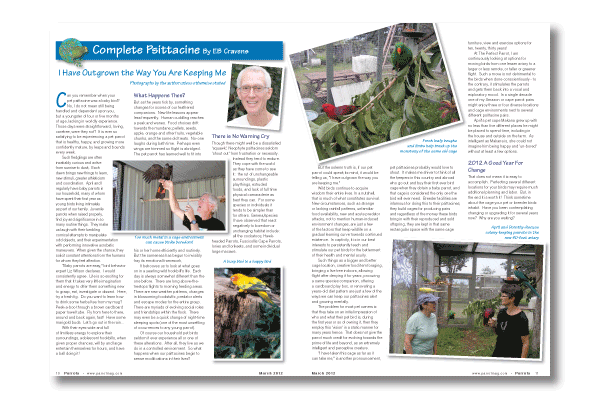
I Have Outgrown the Way You Are Keeping Me
Can you remember when your pet psittacine was a baby bird? No, I do not mean still being handfed and dependent upon you, but a youngster of four or five months of age, lacking in worldly experience. Those days were straightforward, loving, carefree, were they not? It is ever so satisfying to be experiencing a pet parrot that is healthy, happy, and growing more confidently mature, by leaps and bounds every week.
Such fledglings are often insatiably curious and active from sunrise to dusk. Each dawn brings new things to learn, new stimuli, greater athleticism and coordination. April and I regularly have baby parrots in our household, many of whom have spent their first year as young birds living intimately as part of our family. Juvenile parrots when raised properly, find joy and significance in so many routine things. They make us laugh with their fumbling comical attempts to manipulate odd objects, and their experimentation with performing innovative acrobatic maneuvers. When given the chance, they solicit constant attentions from the humans for whom they feel affection.
Read more in the magazine…
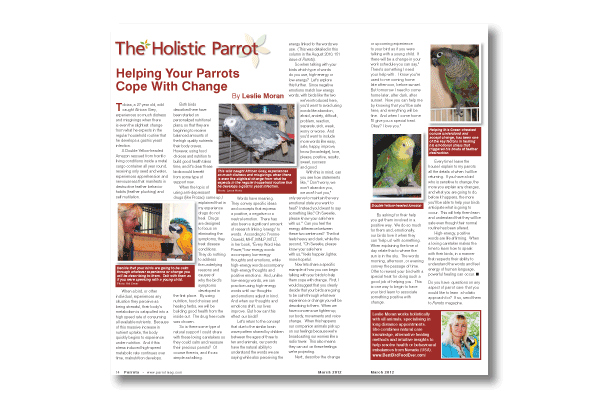
Helping Your Parrots Cope With Change
Tobias, a 27 year old, wild caught African Grey, experiences so much distress and misgivings when there is even the slightest change from what he expects in the regular household routine that he develops a gastric yeast infection.
A Double Yellow-headed Amazon rescued from horrific living conditions inside a metal cargo container all year round, receiving only seed and water, experiences apprehension and nervousness that manifests in destructive feather behavior habits (feather plucking) and self mutilation.
When a bird, or other individual, experiences any situation they perceive as being stressful, their body’s metabolism is catapulted into a high speed rate of consuming all available nutrients. Because of this massive increase in nutrient uptake, the body quickly begins to experience under nutrition. And if this stress induced high-speed metabolic rate continues over time, malnutrition develops.
Read more in the magazine…
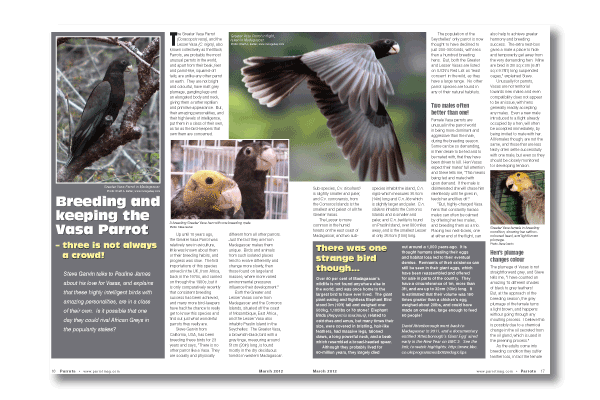
Three is not always a crowd!
Steve Garvin talks to Pauline James about his love for Vasas, and explains that these highly intelligent birds with amazing personalities, are in a class of their own. Is it possible that one day they could rival African Greys in the popularity stakes?
The Greater Vasa Parrot (Coracopsis vasa), and the Lesser Vasa (C. nigra), also known collectively as the Black Parrots, are probably the most unusual parrots in the world, and apart from their beak, feet and parrot-like, squared-off tails, are unlike any other parrot on earth. They are not bright and colourful, have matt grey plumage, gangling legs and an elongated body and neck, giving them a rather reptilian and primitive appearance. But, their amazing personalities, and their high levels of intelligence, put them in a class of their own, as far as the bird-keepers that own them are concerned.
Read more in the magazine…
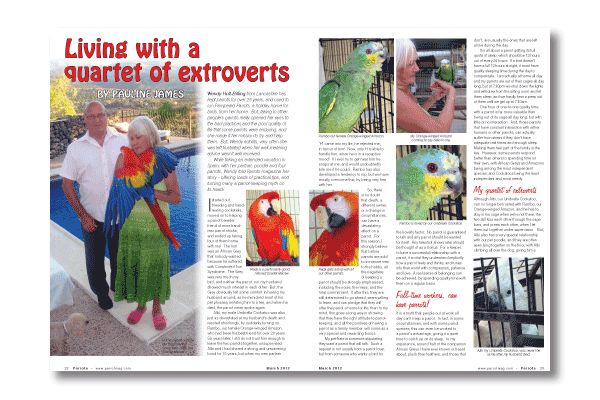
by Pauline James
Wendy Holt-Billing from Lancashire has kept parrots for over 25 years, and used to run Pampered Parrots, a holiday home for birds, from her home. But, taking in other people’s parrots really opened her eyes to the bad practices and the poor quality of life that some parrots were enduring, and she made it her mission to try and help them. But, Wendy admits, very often she was left frustrated when her well-meaning advice wasn’t well received.
While taking an extended vacation in Spain, with her partner, poodle and four parrots, Wendy told Parrots magazine her story - offering loads of practical tips, and turning many a parrot-keeping myth on its head!
I started out, breeding and hand-rearing cockatiels, moved on to helping a parrot breeder friend of mine hand-rear parrot chicks, and ended up taking four of them home with me! The first was an African Grey that nobody wanted because he suffered with Constricted Toe Syndrome. The Grey was very much my bird, and neither the parrot, nor my husband showed much interest in each other. But, the Grey obviously felt some comfort in having my husband around, as he mimicked most of his pet phrases, imitating him to a tee, and when he died, the parrot never spoke again.
Read more in the magazine…
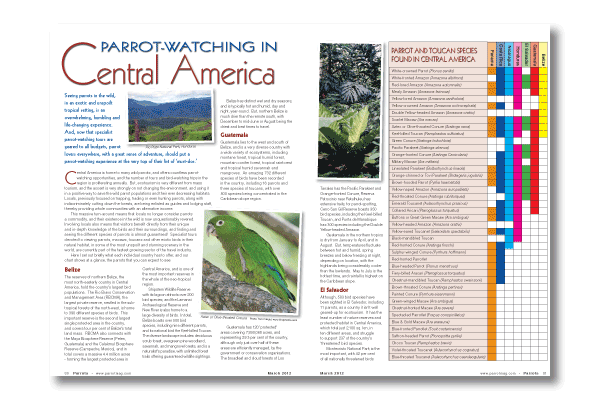
Seeing parrots in the wild, in an exotic and unspoilt tropical setting, is an overwhelming, humbling and life-changing experience. And, now that specialist parrot-watching tours are geared to all budgets, parrot lovers everywhere, with a great sense of adventure, should put a parrot-watching experience at the very top of their list of ‘must-dos.’
Central America is home to many wild parrots, and offers countless parrot-watching opportunities, and the number of tours and bird-watching trips in the region is proliferating annually. But, ecotourism is very different from mass tourism, and the accent is very strongly on not changing the environment, and using it in a positive way to save the wild parrot populations and their ever decreasing habitats. Locals, previously focused on trapping, trading or even hunting parrots, along with indiscriminately cutting down the forests, are being enlisted as guides and lodging staff, thereby providing whole communities with an alternative income.
This massive turn-around means that locals no longer consider parrots a commodity, and their existence in the wild is now unquestionably revered. Involving locals also means that visitors benefit directly from their unique and in-depth knowledge of the birds and their surroundings, and finding and seeing the different species of parrots is almost guaranteed! Specialist tours devoted to viewing parrots, macaws, toucans and other exotic birds in their natural habitat, in some of the most unspoilt and stunning scenery in the world, are currently part of the fastest growing sector of the travel industry.
Here I set out briefly what each individual country has to offer, and our chart shows at a glance, the parrots that you can expect to see.
Read more in the magazine…
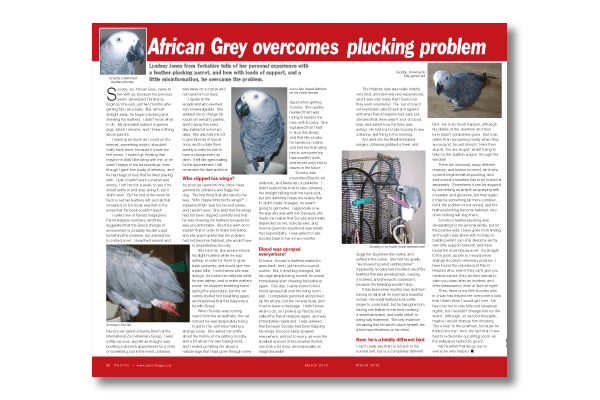
Lyndsey Jones from Yorkshire tells of her personal experience with a feather-plucking parrot, and how with loads of support, and a little misinformation, he overcame the problem.
Scooby, our African Grey, came to live with us, because his previous owner developed Tinnitus (a ringing in the ear), just two months after getting him, as a baby. But, almost straight away, he began plucking and chewing his feathers. I didn’t know what to do. My specialist subject is guinea pigs, which I rehome, and I knew nothing about parrots.
I read up as much as I could on the Internet, something which I shouldn’t really have done, because it made me feel worse. I ended up thinking that maybe he didn’t like living with me, or he wasn’t happy in his surroundings, even though I gave him loads of attention, and he had bags of toys that he liked playing with. I just couldn’t work out what was wrong. I left him for a week, to see if he would settle in and stop doing it, but it didn’t work. By the end of the week he had no red tail feathers left, and all that remained on his body, was fluff in the areas that his beak couldn’t reach.
Read more in the magazine…






